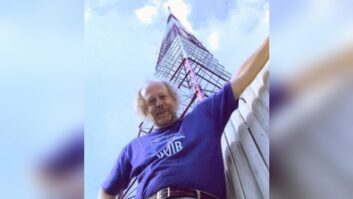
The VOA Collins 821A-1 quarter-megawatt transmitter is shown before removal.
Credit:
Collins Collectors Association

The transmitter extraction crew, from left: Vince Baker of RMC Enterprises, which provides security and maintenance at the VOA site; Rod Blocksome, retired Rockwell Collins high-power transmitter designer; Dennis Kidder, Dave Jennings and Jim Stitzinger, all CCA board members; and Tim Zeichik, assistant to Stitzinger.
Credit:
Collins Collectors Association Since my involvement with the Voice of America’s Delano, Calif., shortwave transmitting station began in the early 1990s, I’ve written many thousands of words about that facility.
In the March 2014 Radio World article “VOA’s Delano Goes on the Block,” I wrote that the General Services Administration had imminent plans to auction off the Delano station real estate to commercial interests. I was fairly certain those words would be my last on the subject of the nearly 70-year-old facility — ashes to ashes, dust to dust, Requiescat in Pace.
However, I was wrong.
I recently visited a small, northern New York town more than 2,200 miles from the transmitting site to report yet another chapter in the Delano story. The location is a storage facility belonging to the Antique Wireless Association Museum, where some 44,000 pounds of “Delano” is now resting.
I’m referring to one of the three model 821A-1 Collins Radio 250,000-watt transmitters that were in daily use at Delano from the mid-1960s until the facility went dark at the end of September in 2007.
A labor of love — and some fairly serious money — saved this Cold War relic from the landfill or a metal recycler.
CONCEIVE A PLAN
The rescue plan actually had its roots in an alliance struck in 2013 between the AWA and another historically minded group, the Collins Collectors Association. The entities had pooled their resources to create The Collins Radio Heritage Group, an organization with the stated objective of “fostering the preservation of the history and equipments of Collins Radio.”
When the idea of saving one of the big Delano Collins rigs — one of only nine such transmitters ever made — from destruction surfaced in September of that year, the CRHG moved into action.
According to CCA President Bill Carns, the plan came about during a dinner meeting with Jim Stitzinger, a CCA board member.

The big rig is loaded for journey to its new home in New York. A portion of the Delano antenna farm is visible in the background.
Credit:
Collins Collectors Association “The topic of Delano kept coming up,” said Carns. “I remarked wouldn’t it be wonderful if we could figure out how to save one of those transmitters. The conversation led to the weight and size of the rig, and Jim volunteered that he had a large warehouse about 25 miles from the Delano site.” If they could obtain one, they could store it there.
Carns said that, thanks to the alliance between his organization and the AWA, it didn’t take a lot of persuasion to get the Bloomfield, N.Y., historical group to buy in.
“The concept came up in the fall of 2013,” said the AWA Deputy Director Bob Hobday. “We had been operating on a loose arrangement with the CCA, trying to preserve whatever Collins equipment came up. They said, ‘Could we?’ … and we [then] reached out to the Voice of America. They got excited about the concept of us saving a transmitter and putting it on display. At that time, however, they had committed to the disbursement of [the transmitters] through the General Services Administration. Although they were in support of the plan and made this known to the General Services Administration, we had to apply through the New York State General Service Administration and demonstrate that we were a 501(c)3 organization.
“In May of 2014, we received a letter that was good news and bad news — the good news was that ‘you’ve got it’ and the bad news was ‘you have two weeks to get it out of there.’”

Two large trucks were needed to transport the 821A-1 transmitter and associated control room equipment.
Credit:
Collins Collectors Association

Bill Carns.
Credit:
Photo by James E. O’Neal Stitzinger and some others had organized a team that committed to go to Delano as soon as the arrangement was finalized, Hobday said. “They went out there and spent two weeks taking apart and documenting the world’s largest ‘erector set.’”
In all, nearly a dozen people were involved in disassembling and readying the transmitter for its journey to Bloomfield. It was packed in some 128 boxes; Carns referrred to it as “the Heathkit from hell.” He noted that the 821A-1 was created by Collins specifically to address a “request for proposals” issued by the VOA in the 1960s. Collins got the award and rolled out three transmitters for transmitting stations at Delano and Dixon, Calif., and Bethany, Ohio, all part of a modernization program.
NEXT FOR THE BIG RIG?
Not only the 25-foot long transmitter and associated power supply and modulation components, but much of the Delano control and monitoring facility was also disassembled and packed for shipping to Bloomfield. Two trucks were needed to transport the more than 22 tons of equipment. According to Hobday, in addition to considerable manpower and lifting equipment, more than $20,000 was required to extract the transmitter and move it across the country.
Everything arrived safely and plans are underway now to reassemble the gear into a major exhibit at the AWA Museum. The museum has been in existence for more than 60 years and last year left its previous home of nearly 40 years in the Bloomfield Historical Society Academy building for the 10,000 square foot building it now occupies. The AWA has some 1,800 members worldwide.
Plans include recreation of the Delano control room, which contained equipment for monitoring and controlling all seven quarter-megawatt transmitters used at the facility (there were also four later ASEA Brown Boveri rigs, subsequently relocated to other VOA facilities), and the incoming audio feeds from the VOA’s studio and operations facility in Washington, D.C.
The reassembly and display is on a strict timeline, according to Carns.
“We have to have the transmitter on display within 12 months of its removal date,” he said. “We are under the gun to get the next stage of work done. As you can imagine, siting that transmitter is not a trivial task. You just don’t open the door and push it in.”
While it’s obvious that the 250,000-watt behemoth will never hurl its thunderbolts again (it required a 4,160 volt three-phase power connection and drew some 500 kilowatts), the museum does plan to supply low-voltage power to the big rig’s indicator panel to simulate its operation for visitors.
According to Hobday, plans have been made to put the transmitter on display by summer 2015. However, funding is still needed to create the complete exhibit. Carns said a fundraising effort is underway to support the Collins transmitter project.

Bob Hobday poses with the remote control unit for the three Collins systems.
Credit:
Photo by James E. O’Neal “We’ve been fortunate that people have donated toward the extraction and moving of the transmitter, but we’re now looking for support to allow us to develop the next phase,” said Hobday. “We’re developing plans for a 400-square-foot display. Imagine being able to stand in the control room of the Delano station, listen to the Voice of America programming going on, and see the transmitter just beyond the control room.
“You ask anybody under 35 years old now and they have no idea what the Voice of America is. We have a responsibility to tell their story — what it means to freedom.”
WHAT’S NEXT FOR DELANO?
As previously reported, the U.S. General Services Administration had the final say as to what would happen with the Delano property, which consists of a 20,000 square-foot building and several smaller support structures, along with numerous HF antennas, on a nearly square mile of land in California’s San Joaquin Valley.
When contacted in late 2013, David Evans, a supervisory property management officer at the IBB, stated that proposed plans for the property, including its use as a U.S. Marine Corps training facility and a homeless shelter, had fallen through and that the GSA was readying to auction the property to private sector interests. However, in a November 2014 telephone conversation, Evans reported another twist in the facility’s long history.

The Antique Wireless Association Museum plans to feature the Collins 821A-1 transmitter and a recreation of the Delano VOA control room in a special exhibit.
Credit:
Photo by James E. O’Neal “The City of Delano has put in an application to create an airport on the site,” said Evans. “And the FAA has asked the city to do a feasibility study.”
If this scenario is approved, it’s conceivable that part of the former broadcasting facility might live on as administrative and support facilities for the proposed airport; however, the antenna farm with its two large curtain arrays and numerous rhombics would have to go. Evans reported that the antennas were still standing and that the two remaining Collins 821A-1 transmitters remained in place in the cavernous building.
“The other two transmitters are still on the VOA books until GSA turns them over to whomever gets the land,” said Evans.
For additional information on the project how to provide support for it, visit www.antiquewireless.org, collinsradio.com or collinsradioheritagegroup.org.
Comment on this or any story to[email protected].












